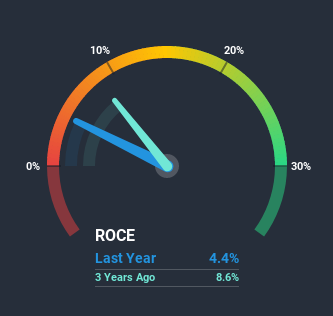What Do The Returns On Capital At National Aerospace Fasteners (TPE:3004) Tell Us?

There are a few key trends to look for if we want to identify the next multi-bagger. Ideally, a business will show two trends; firstly a growing return on capital employed (ROCE) and secondly, an increasing amount of capital employed. This shows us that it's a compounding machine, able to continually reinvest its earnings back into the business and generate higher returns. However, after investigating National Aerospace Fasteners (TPE:3004), we don't think it's current trends fit the mold of a multi-bagger.
Return On Capital Employed (ROCE): What is it?
Just to clarify if you're unsure, ROCE is a metric for evaluating how much pre-tax income (in percentage terms) a company earns on the capital invested in its business. The formula for this calculation on National Aerospace Fasteners is:
Return on Capital Employed = Earnings Before Interest and Tax (EBIT) ÷ (Total Assets - Current Liabilities)
0.044 = NT$173m ÷ (NT$4.5b - NT$566m) (Based on the trailing twelve months to September 2020).
Thus, National Aerospace Fasteners has an ROCE of 4.4%. Ultimately, that's a low return and it under-performs the Machinery industry average of 9.3%.
View our latest analysis for National Aerospace Fasteners

Historical performance is a great place to start when researching a stock so above you can see the gauge for National Aerospace Fasteners' ROCE against it's prior returns. If you'd like to look at how National Aerospace Fasteners has performed in the past in other metrics, you can view this free graph of past earnings, revenue and cash flow.
What Does the ROCE Trend For National Aerospace Fasteners Tell Us?
In terms of National Aerospace Fasteners' historical ROCE movements, the trend isn't fantastic. Around five years ago the returns on capital were 14%, but since then they've fallen to 4.4%. Given the business is employing more capital while revenue has slipped, this is a bit concerning. If this were to continue, you might be looking at a company that is trying to reinvest for growth but is actually losing market share since sales haven't increased.
On a related note, National Aerospace Fasteners has decreased its current liabilities to 13% of total assets. So we could link some of this to the decrease in ROCE. What's more, this can reduce some aspects of risk to the business because now the company's suppliers or short-term creditors are funding less of its operations. Some would claim this reduces the business' efficiency at generating ROCE since it is now funding more of the operations with its own money.In Conclusion...
In summary, we're somewhat concerned by National Aerospace Fasteners' diminishing returns on increasing amounts of capital. Investors must expect better things on the horizon though because the stock has risen 16% in the last five years. Either way, we aren't huge fans of the current trends and so with that we think you might find better investments elsewhere.
One more thing to note, we've identified 3 warning signs with National Aerospace Fasteners and understanding them should be part of your investment process.
While National Aerospace Fasteners isn't earning the highest return, check out this free list of companies that are earning high returns on equity with solid balance sheets.
If you decide to trade National Aerospace Fasteners, use the lowest-cost* platform that is rated #1 Overall by Barron’s, Interactive Brokers. Trade stocks, options, futures, forex, bonds and funds on 135 markets, all from a single integrated account. Promoted
If you're looking to trade National Aerospace Fasteners, open an account with the lowest-cost platform trusted by professionals, Interactive Brokers.
With clients in over 200 countries and territories, and access to 160 markets, IBKR lets you trade stocks, options, futures, forex, bonds and funds from a single integrated account.
Enjoy no hidden fees, no account minimums, and FX conversion rates as low as 0.03%, far better than what most brokers offer.
Sponsored ContentValuation is complex, but we're here to simplify it.
Discover if National Aerospace Fasteners might be undervalued or overvalued with our detailed analysis, featuring fair value estimates, potential risks, dividends, insider trades, and its financial condition.
Access Free AnalysisThis article by Simply Wall St is general in nature. It does not constitute a recommendation to buy or sell any stock, and does not take account of your objectives, or your financial situation. We aim to bring you long-term focused analysis driven by fundamental data. Note that our analysis may not factor in the latest price-sensitive company announcements or qualitative material. Simply Wall St has no position in any stocks mentioned.
*Interactive Brokers Rated Lowest Cost Broker by StockBrokers.com Annual Online Review 2020
Have feedback on this article? Concerned about the content? Get in touch with us directly. Alternatively, email editorial-team@simplywallst.com.
About TWSE:3004
National Aerospace Fasteners
Engages in the manufacture, processing, agency, and trading of various types of fasteners and construction parts and related components of aircraft and automobiles in Taiwan and internationally.
Reasonable growth potential with adequate balance sheet.
Market Insights
Community Narratives



